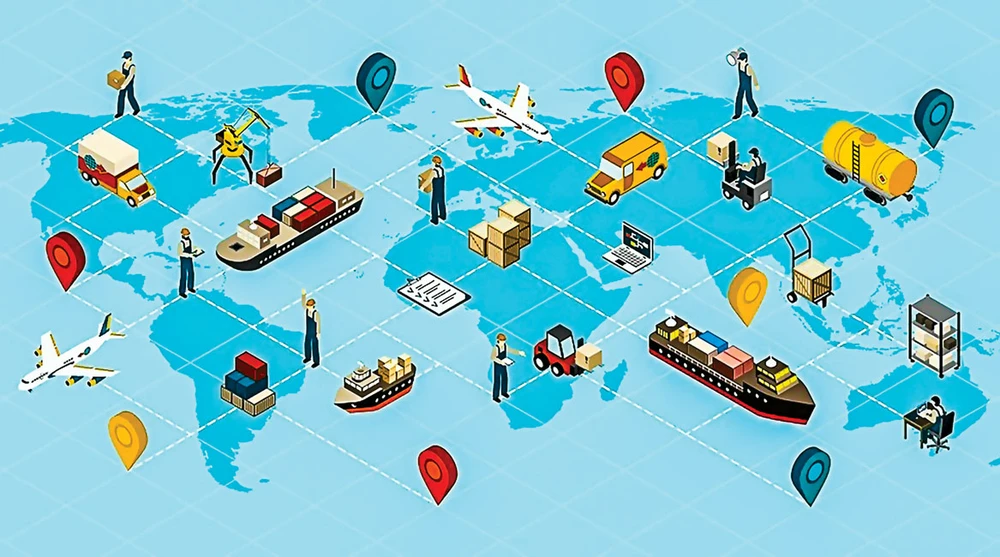
All this could possibly bring about very productive opportunities for Vietnam to diversify its resources across various supply sources and follow a new course in trade.
Setbacks and obstacles
More than ten years ago, when Mr. Truong Dinh Tuyen was the Minister of Trade, he had a vision to make Vietnam a focal market for regional and global raw materials. Mr. Tuyen nurtured this vision based on the fact that Vietnam has all the conditions for manufacturing many products. The country has a favorable geographical location and a strong and rational economic policy, and many FTAs had been signed with several partner countries.
However, in the first few years of joining the World Trade Organization (WTO), Mr. Tuyen noticed the biggest and weakest setback Vietnam faced was that the country was too dependent on import of materials from outside, mainly from China. Although Vietnam produced many goods and also exported a substantial amount of products, the country was not in a position to bargain prices, which is both a paradox and a disadvantage.
For all the rational reasons, Mr. Truong Dinh Tuyen could not realize his vision at that time, and within three years of joining the WTO, weaknesses in the supply chain of input materials in some export industries such as textiles, footwear, and wooden furniture began to surface. The Government began a plan to implement projects to develop materials in order to supply on site for a number of key export products, but these projects have either been shelved or not had the desired results.
Mr. Pham Quoc Doanh, former Deputy Head of the Enterprise Development and Reform Steering Committee under the Government, acknowledged that after decades of development, Vietnam has still not been able to build the supply of raw materials properly. For example, the planning of cotton growing areas, which is considered the backbone of the textile and apparel industry, has been in planning stage since 2010 and facing structural difficulties and obstacles in land clearances, among many other reasons.
Besides not mastering the supply of input materials, Vietnam's support industries have not even created a basic foundation yet. At present, a number of industries in electronics, textiles, leather and footwear, and assembly of cars and motorbikes, still do not have a support industry and rely heavily on import of raw materials and components, causing passive production as well as higher production costs. These are the two weaknesses that economists consider to be "double obstacles" that are impeding Vietnam's export industry.
Opportunity to diversify
When China, known as the "world's factory," became the epicenter of the outbreak of the Covid-19 pandemic, the entire global manufacturing supply chain was disrupted. Now in an effort to move the production supply chain out of China, the US recently revived the “Quadrilateral Security Dialogue” (QSD) which was initiated in 2007 between the United States, Japan, Australia and India.
After several years of being in limbo, this group of four countries has resumed a four-party dialogue and upgraded it to the level of their country’s foreign ministers. Now, QSD is seeking to add three more countries of South Korea, New Zealand and Vietnam in its joint discussions. Mr. Le Xuan Nghia (PhD), a member of the Economic Advisory Group to the Prime Minister, said that the US is a major trading partner of Vietnam, but the US has long been separated from the Asia-Pacific trade bloc, which is a disadvantage for Vietnam. With the decision to establish a prosperous economic network, a dialogue with QSD with three more countries will be an opportunity for Vietnam to restore its strategic position in the US market.
In a report dated May 2020, the World Bank said that Vietnam is a promising destination for a wave of factories to relocate from China, increase its export turnover and attract more Foreign Direct Investment (FDI) and Foreign Institutional Investment (FII) seeing the present status of Vietnam's macro-economic situation.
EVFTA is expected to be ratified by the National Assembly on May 20 on the first day of the 9th Session of the 14th National Assembly. After being ratified by the National Assembly, the EU and Vietnam will complete the notification process, and EVFTA will then officially be in effect. The US wants Vietnam to join the QSD Group and along with EVFTA it will be a dual opportunity for the country to implement the policy of effectively shifting and diversifying sources of supply and reducing excessive reliance on one market.
Speaking with Saigon Investment, economist Pham Chi Lan, a former member of the Prime Minister's Research Board, said that this was a great opportunity for Vietnam and the country’s economy. The problem now is only how Vietnam will take advantage of these opportunities and achieve its goals. According to Ms. Pham Chi Lan, the key to using opportunities for change, and successfully diversifying the supply chain, while developing content of added value, is the approach taken by the enterprises, which is the core of the economy. She believes that if businesses do not change and push themselves to the next level, they will still remain at the lowest levels of the value chain. This will eventually mean that the value chain and the economy of Vietnam will still remain static.




















